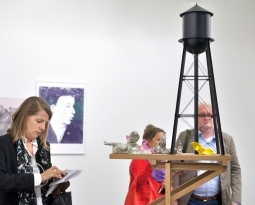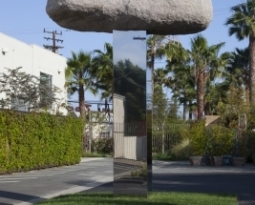The Pace Gallery‘s gamble in choosing young multidisciplinary artist Sterling Ruby for their first solo by a Western artist at their Beijing outpost has paid off. What seemed a rather surprising choice — even to Ruby himself — has delivered the gallery a trifecta of critical, popular, and business success.
Ten days out from the close of the show, some 25 percent of the works had been sold — a statistic that might seem modest until you consider just how monumental the pieces are. Each was apparently scaled to fit the arching Bauhaus spaces of the gallery, which is housed in one of the largest spaces in the decommissioned military factory complex that is home to Beijing’s premier art district, 798. These are not works a collector picks up lightly.
Even more encouraging to Pace, from a business perspective, is that all of the sales went to mainland Chinese or Asian collectors, some — according to Pace Beijing president Leng Lin — with no track record of collecting Western contemporary art.
Just as pleasing to Pace, according to Leng, is the enthusiastic embrace of the show by Beijing’s critical and artist community. Certainly Chinese artists, who rarely come to exhibitions at all, turned out in force both at the opening and, more discreetly, during the run. Previously Pace’s Western artists have been tucked into “all-star” group shows with Chinese counterparts likeZhang Xiaogang and Li Songsong, so the gallery’s choice of Ruby for their first solo showed a canny reading of the state of the Chinese art scene.
Titled “Vampire,” Ruby’s show was indeed perfectly calibrated to the scale of Pace Beijing’s space, but more importantly it seemed — with its giant metal “monuments,” “bloodied” urethane stalagmite sculptures, and spray-painted camouflage-like canvases — to resonate as much with China at this point in history as with the United States of America that it more overtly addresses.
Ruby shared his impressions of making art in the People’s Republic with ARTINFO China.
Can you tell us about your experience to date in China?
I’ve come here eight times since 2008 [when he exhibited in a group show at the Ullens Center of Contemporary Art in Beijing]. The first time I came I had no idea what it was going to be like. At that time most of my peers, and frankly most of my friends, tended to be rather dismissive of China. So when I arrived the first thing I noticed was that there was a reverence here for contemporary art, which in America we just don’t get. My generation, we’re very cynical, tongue-in-cheek, and very critical about that kind of reverential dialogue about creativity. It just seems passé to us.
And here it’s just the reverse?
Yes. I liked all the energy that was coming off the artists and the curators and the museum people and, especially, from the public.
People actually think art’s important here.
Yes! It’s super refreshing! And just the other day in New York we were talking about the fact that the 798 Art District is the third most popular tourist destination in Beijing. Can you imagine that happening in Chelsea? I think that’s a hopeful thing.
Can you describe what you’ve been doing in China leading up to this show?
I’ve been working here for the past eight months, working at a foundry outside the city. Most of the larger metal works in the show have been produced here. And the paintings and soft sculptures were done in Los Angeles.
It’s a noticeable trend how many Western artists are now setting up studios or doing work here.
Well, just to talk about the technical aspect of working here — if we just limit our discussion to bronze fabrication — we have a bronze fabricator we work with in Los Angeles, one in Belgium, and one here in Beijing. There is a difference in the way they treat the material, but the one thing that I’ve really liked here is the level of technical prowess. I mean it’s not necessarily cheaper to work here; I tend to note that because people always say, “Oh, it must be so cheap!” It’s not actually any cheaper when you consider that you have to fly here and set up house and a studio and so on — but you can certainly do things a lot quicker in China.
There’s certainly an enthusiasm you find here for the work.
At the foundry there is that enthusiasm you talk about — when I first started working there we didn’t know exactly what we were going to make. It wasn’t pre-determined, we didn’t have a blueprint, and that seemed to take them by surprise [laughs]. I think they are used to getting a finished design from the artist and the foundry takes it from there. But we said, “No, we really want to actually create work in the foundry.” My only prerequisite was that they have about three tons of clay on hand. And, again, this was a different working order for them too — they didn’t normally have artists working on the premises. It was liberating to be able to work that way and be able to do things so immediately. And when I was done, their team would come in and chop it up and cast it and in the end within six months we had completed the entire edition, and that would have taken over a year somewhere else.
And you were in fact coming and going during that period?
Yes, we were flying back and forth.
Tell me about the process of choosing to work in the foundry in Beijing?
When Leng Lin and I decided that we were going to do the show, we agreed that I would create the bronze works in a foundry in Beijing, and that’s how we set it up.
At what point did you and Leng Lin start to talk about doing a show together?
I first met Leng Lin two years ago and we seemed to have a pretty good rapport straight away, but it took about a half a year for him to get to know my work, to see the work. In the end it was his choice, he asked me to do the first solo show by a Western artist at Pace Beijing. I was quite surprised — I mean he works for Pace, so he had quite a lot of options!
Yes, I guess I would have expected him to have made a more “classic” choice. Your name was a bit of a surprise.
I was a bit surprised too — I thought they would choose one of their bigger artists.
Tell me a bit more about your friends’ reaction to you working and showing in China?
As one of a group of 40-something generation of American artists I found that most of my peers were cynical about China. They could see the market phenomena surrounding Chinese contemporary art, but nothing beyond that.
But what I found was something else. When I looked at the previous generation of Chinese artists, people like Zhang Huan or Zhang Xiaogang, who I had met through Leng Lin, I really liked the aspect of autobiography in their work. Autobiography is something that artists of my generation were really cautioned to stay away from. I found being around the art scene here quite liberating.
It’s interesting that you use the word liberating for your experience here. Can you talk a bit more about that?
My generation has been carrying this burden of trying to make art that is premeditated, which doesn’t necessarily allow you to have a practice that is intuitive. And I don’t know whether it’s just a thing of me getting comfortable with what I do, but I feel I’m much happier thinking about it in that way, as innate, rather than always attaching an external framework, and it seems like a lot of other artists are feeling that too, right now.
Did you work that way in the foundry, going in without a preconception of what you wanted to make?
Actually I can’t say I had no ideas at all going into it. The bronze basin pieces that we made in China came out of the ceramic works that I have been doing. For about ten years I had been making figurative, skeletal-looking ceramic shapes. Because of their strange shapes a lot of them would blow up during the firing process, and I’ve kept the scraps and broken pieces. I started putting these into large ceramic basins, which I have come to think of as my own version of an archaeological dig site. I am doing this reclaiming and reassessing of materials not just with the ceramic works but with the paintings and collages and so on. In coming to the foundry, I knew I wanted to create works that tapped into that idea of personal archaeology, and that’s where all the work took off from.
And the whole archaeological thing, of course, is apropos in China.
Yes, the dig site — especially in Beijing — is like a daily occurrence. Also the foundry is set up on probably eight to 10 acres of land, and they throw their scrap everywhere, so this idea of the dig site, the excavation, turned out to revive itself when we were in China. I mean, I’d been doing it in my own studio, and I ended up incorporating some discarded remnants from around the foundry into my own project. I don’t want to play off that too much as a kind of romantic scenario, but there was a very straightforward way of working that I found here, in terms that you use what’s available and then you make something with it.
Looking at your work, it seems the kinds of things you have been working on have for a long time have a special resonance with China. Is that something you recognized when you first came here in 2008?
Yes, absolutely. I mean, the place itself just felt unfettered to me. And I don’t want to make it seem like I just came here because I was looking to pick out a place where change was happening at a very fast pace. What I felt when I came here was similar to what I felt going to Los Angeles 10 years ago. Los Angeles has this feeling of lawlessness. I still love Los Angeles — that’s where I live. When I was growing up, the expected situation for an artist was that you would move to New York. But then I started noticing that in Los Angeles there were a lot of influential artists whom I admired, and so I decided to move there for my graduate studies. I felt that same energy in China when I came here first. Artists were holing up and making work, trying to figure out where their society and culture were going.
So many real artists here have that same attitude, which makes it odd that there is so much commentary from the West that Chinese artists are just making art for the market.
I think that commentary is just bullshit.
Do you want to tell us a bit about interacting with other artists here?
When I have studio visits in L.A. they often seem very perfunctory, whereas here, when I met with Zhang Xiaogang… well, it took a little while [laughs], but then it opened up into such an enormously important dialogue between us, not only about social history and his country’s history but also his own autobiography. It was great.
http://www.artinfo.com/news/story/749603/artist-sterling-ruby-on-why-beijing-is-the-new-la





